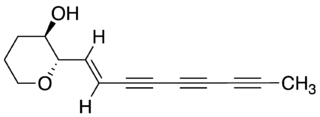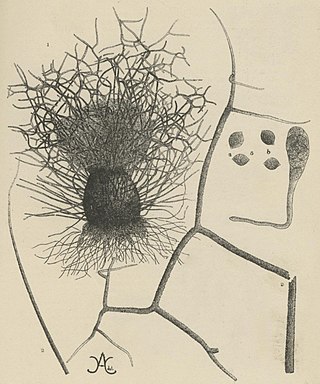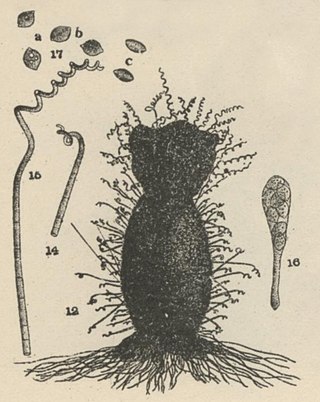
Rutabaga or Swede is a root vegetable, a form of Brassica napus. Other names include Swedish turnip, neep (Scots), and turnip. However, elsewhere, the name "turnip" usually refers to the related white turnip. The species Brassica napus originated as a hybrid between the cabbage and the turnip. Rutabaga roots are eaten as human food in various ways, and the leaves can be eaten as a leaf vegetable. The roots and tops are also used for livestock, fed directly in the winter or foraged in the field during the other seasons. Scotland, Northern and Western England, Wales, the Isle of Man, and Ireland had a tradition of carving the roots into Jack-o'-lanterns at Halloween.

Daucus carota, whose common names include wild carrot, European wild carrot, bird's nest, bishop's lace, and Queen Anne's lace, is a flowering plant in the family Apiaceae. It is native to temperate regions of the Old World and was naturalized in the New World.
Sesquiterpene lactones (SLs) are a class of sesquiterpenoids that contain a lactone ring. They are most often found in plants of the family Asteraceae. Other plant families with SLs are Umbelliferae and Magnoliaceae (magnolias). A collection of colorless, lipophilic solids, SLs are a rich source of drugs. They can be allergenic and toxic in grazing livestock causing severe neurological problems in horses. Some are also found in corals of the order Alcyonacea.

Pickling is the process of preserving or extending the shelf life of food by either anaerobic fermentation in brine or immersion in vinegar. The pickling procedure typically affects the food's texture and flavor. The resulting food is called a pickle, or, if named, the name is prefaced with the word "pickled". Foods that are pickled include vegetables, fruits, mushrooms, meats, fish, dairy and eggs.

A polyyne is any organic compound with alternating single and triple bonds; that is, a series of consecutive alkynes, (−C≡C−)n with n greater than 1. These compounds are also called polyacetylenes, especially in the natural products and chemical ecology literature, even though this nomenclature more properly refers to acetylene polymers composed of alternating single and double bonds (−CR=CR′−)n with n greater than 1. They are also sometimes referred to as oligoynes, or carbinoids after "carbyne" (−C≡C−)∞, the hypothetical allotrope of carbon that would be the ultimate member of the series. The synthesis of this substance has been claimed several times since the 1960s, but those reports have been disputed. Indeed, the substances identified as short chains of "carbyne" in many early organic synthesis attempts would be called polyynes today.

The carrot is a root vegetable, typically orange in color, though heirloom variants including purple, black, red, white, and yellow cultivars exist, all of which are domesticated forms of the wild carrot, Daucus carota, native to Europe and Southwestern Asia. The plant probably originated in Iran and was originally cultivated for its leaves and seeds.

Taste receptor 2 member 38 is a protein that in humans is encoded by the TAS2R38 gene. TAS2R38 is a bitter taste receptor; varying genotypes of TAS2R38 influence the ability to taste both 6-n-propylthiouracil (PROP) and phenylthiocarbamide (PTC). Though it has often been proposed that varying taste receptor genotypes could influence tasting ability, TAS2R38 is one of the few taste receptors shown to have this function.
Chaetomium cupreum is a fungus in the family Chaetomiaceae. It is able to decay in manufactured cellulosic materials, and is known to antagonize a wide range of soil microorganisms. This species is component of the biocontrol agent, Ketomium, a commercial biofungicide. It has also been investigated for use in the production of natural dyes. Chaetomium cupreum is mesophilic and known to occur in harsh environments and can rapidly colonize organic substrates in soil. Laboratory cultures of C. cupreum can be propagated on a range of common growth media including potato dextrose at ambient or higher than ambient temperature producing cottony white colonies with a reddish reverse.

Mellein is a dihydroisocoumarin, a phenolic compound produced by the mold species Aspergillus ochraceus.

6-Methoxymellein is a dihydroisocoumarin, a phenolic compound found in carrots and carrot purées. It is responsible for bitterness in carrots. It is a phytoalexin, induced in carrot slices by UV-C, that allows resistance to Botrytis cinerea and other microorganisms.

Falcarindiol is a polyyne found in carrot roots which has antifungal activity. Falcarindiol is the main compound responsible for bitterness in carrots. Falcarindiol and other falcarindiol-type polyacetylenes are also found in many other plants of the family Apiaceae, including some commonly used seasonings such as dill and parsley.

Chaetoglobosin A is a fungal isolate with anticancer activity in vitro. Derivatives of the compound include MBJ-0038, MBJ-0039, and MBJ-0040.

Chaetoxanthones are a class of chemical compounds which are classified as xanthones. They have been isolated from marine-derived fungi in the genus Chaetomium. There are four compounds in the class that are designated as chaetoxanthones A through D. A laboratory synthesis of (±)-chaetoxanthone B has been reported. The chaetoxanthones are under investigation as potential antimalarials.
Chaetomium grande is a fungus species in the Chaetomium genus, first isolated from Iran. It shares features such as peridium structure, ascospore morphology and germ pore position with its cogenerates. It is closely related to C. megalocarpum.

Chaetochromin, also known as 4548-G05, is an orally active, small-molecule, selective agonist of the insulin receptor. It has potent and long-lasting antidiabetic activity in vivo in mice. The drug may represent a novel potential therapeutic agent for the treatment of diabetes which is more convenient and tolerable to administer than injected insulin. It was discovered in 1981 in Chaetomium gracile fungi, and its interaction with the insulin receptor was identified in 2014.
Botryotrichum murorum is a common soil and indoor fungus resembling members of the genus Chaetomium. The fungus has no known asexual state, and unlike many related fungi, is intolerant of high heat exhibiting limited growth when incubated at temperatures over 35 °C. In rare cases, the fungus is an opportunistic pathogen of marine animals and humans causing cutaneous and subcutaneous infection.

Chaetomium elatum is a very common and widely distributed saprotrophic fungus of the Chaetomiaceae family of molds which has been found to grow on many different substances all over the world. It was first established by Gustav Kunze after he observed it growing on dead leaves. Its defining features that distinguish it from other Chaetomium species are its extremely coarse terminal hairs and the lemon-shaped morphology of its ascospores. It produces many metabolites with potential biotechnology uses including one with promise against the rice blast disease fungus, Magnaporthe grisea. It shows very little pathogenic ability causing confirmed disease in only a few plant species.

Chaetomium subspirale is a fungus from the phylum Ascomycota. It was described by A. H. Chivers in 1912 in America. The species has sexual fruiting bodies that are ornamented with characteristic, coiled hairs giving it a wooly appearance. C. subspirale colonies are brown, which the characteristic hairs are also responsible for. It is commonly found in various soil and dung samples. C. subspirale produces the mycotoxin, oxaspirodion, which inhibits inducible TNF-a expression and inhibits the activation of the transcription factor NF-kappaB.
Arcopilus aureus is a plant and soil fungus in the genus Arcopilus. It was first identified by A. H. Chivers in 1912, who named it Chaetomium aureum. It was later transferred to the genus Arcopilus by Wang and colleagues. The fungus has recently been recognized to have industrial use for the production of the metabolites resveratrol. and sclerotiorin Additionally, A. aureus has high lead tolerance and clearance, suggesting a potential role in environmental biotechnology.
Chaetomium perlucidum is a neurotropic dematiaceous fungus that is naturally found in the soil, including in agricultural soil, and in the stems of dead plants. The fungus can also be found on the feathers of birds, manure, seeds, and even paper. It is able to thrive at temperatures of 35 and 42 °C.














